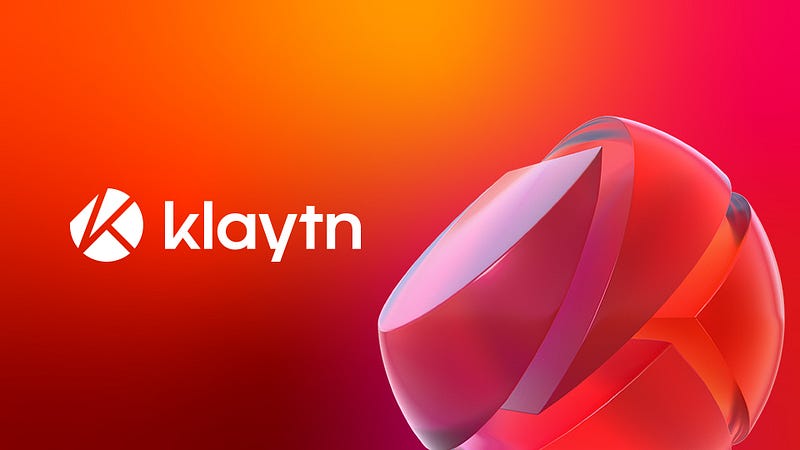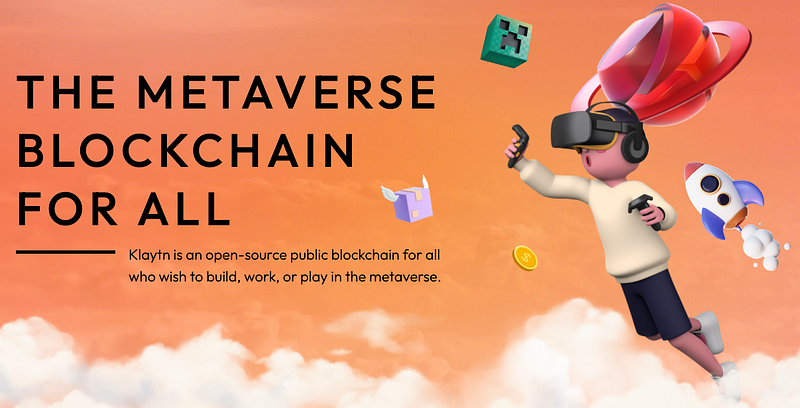Klaytn: The Most Interesting Metaverse Blockchain You’ve (Probably) Never Heard About
Ever heard about Klaytn? Neither had I. Read this to find out about this amazing, interesting and gamechanging metaverse blockchain.

Ever heard about Klaytn? Neither had I. Read this to find out about this amazing, interesting and gamechanging metaverse blockchain.
There’s a buzz in the air. A sense of anticipation. A ‘pregnant pause’ as my English teacher used to say. It’s the sound of untold billions getting ready to be spent (yes, with a B). The sound of trillions (yes, a T) of dollars in market value just waiting, nay begging to be created.
It’s the sound of the metaverse and web3 — and it’s coming to a computer near you
You might have heard about it. Facebook, rebranding as Meta. Sleepy Microsoft announcing its ‘work centric’ metaverse. ‘The Sandbox’, loved by Snoop Dogg and all sorts of brands.
In this article, I’ll introduce you to the most interesting Metaverse Blockchain you’ve probably never heard about: Klaytn. Together, we’ll undertake an investment and product analysis to see what it really is and if it’s really all it promises to be.
Read on to find out more!
What would it take for Crypto, AI, and Cyber to truly change the world?
No spam. Unsubscribe anytime.
All these metaverses (or is the plural metaversii?) being created have caused a bit of a problem. Two problems to be exact. You’ve probably already thought of them, but as a consumer of these metaverses let me be explicit. Do you ever find yourself wondering:
It’s a big problem and only getting worse. And it’s exactly what Klaytn aims to solve.
Let’s explore this compelling and interesting Metaverse Blockchain.

Klaytn calls itself as “The trust layer of the metaverse”. First listed on CoinMarketCap in April 2020, they’ve rapidly found themselves intimately involved in the fast and rapidly evolving area of GameFi, also known as ‘Play-to-Earn’.
They market themselves as offering something different, in three specific areas:
With an all-time high of $4.24 USD (currently $0.2273), and listed on many major exchanges such as Binance, it certainly seems like they’ve got a lot to offer.
However, is this for you?
Disclaimer. As with any project or potential investment, you should exercise caution and Do Your Own Research (DYOR). I’ve linked my research below so you can do exactly that.
Let’s dive into our Klaytn investment analysis. We’ll explore four areas:
A projects developer resources are a great way to confirm their likelihood of success. If a project is easy to use, makes it easy for others to use, and lowers the barriers to entry for their product, they’ll have a much greater chance of being successful.
Klaytn ticks a number of boxes in this area. Their developer resources are:
In a fast-innovating environment such as blockchain, a product roadmap is critical. It demonstrates to users and developers that the project will stay relevant, continue to incorporate the latest advances, and the team is committed to the future.
Klaytn’s Product Roadmap scores a mixed result:
This is a troubling lack of transparency, particularly for such a new project (only started in 2019), and has been addressed by many of their industry peers.
Any blockchain project not backed by industry giants requires broad adoption to build successfully. This raises the project to a higher level of mindshare, which encourages more early adopters to use the product. It gives them space, time and money to implement their vision.
Klaytn appears to be doing extremely well in this area. Their ecosystem page shows broad industry buy in for the project, as well as a number of active development projects. Here’s a few highlights:
It would be safe to say that Klaytn appears to have won significant mindshare in their area of expertise — however this appears to be in the blockchain equivalent of the B2B space. Basically, if you’re a blockchain developer in the Metaverse you’ve probably heard of it. If you’re a casual user, probably not — and hence the title.
Finally, for a community sourced project to be useful, it needs to have access to capital markets. This ensures that they are able to gain the capital required to invest in development.
Klaytn has achieved a high level of penetration into the Crypto capital markets. As well as the previously mentioned Binance, they are listed on many different DEXES and CEXES — a full list of which can be found here.
They also offer a staking product — albeit with a low APY. For instance, on Binance you can stake for 30 days and receive 6.54% (for comparison, many other products on Binance staking offer a much higher APY).
While every investment decision remains your own, here’s a list of what’s been discussed so far:

To fully understand Klaytn, we need to understand how it connects to the overall blockchain ecosystem.
We’ll do this by framing Klaytn within the blockchain ecosystem using the Blockchain Layer Model. While it’s is a simplistic model, and definitely prone to complexities (i.e. do we need layer 2 if layer 1 is fast enough?), it does allow us to understand the target market for Klaytn.
Layer 1 blockchains deal with the actual recording of transactions and smart contracts into blocks. For example, Ethereum or Solana. These are the blockchains which underpin the entire ecosystem, but are limited by one or more of the aspects of the Blockchain Trilemma (decentralised, scalable, secure). Importantly however, any future layer which works on a given layer 1 solution is compatible with all other solutions built on that layer 1 solution.
Layer 2 blockchains such as Polygon aim to provide solutions to one of the Blockchain Trilemma issues, typically speed. These layers use their original layer 1 solution for their block finality, but extend the given layer 1 solutions functionality / usefulness.
Layer 3 onwards deal with end user interactions with blockchain, including metaverse games like Axie Infinity and more. They may use layer 2 solutions as an intermediary to solve a particular issue (i.e. Transactions Per Second or speed).
Even if you’re not a developer, I’m sure you can already imagine that this can be quite a complex environment to develop in. If you want to read more, refer to this article and this article.
The layer model above gives insight into Klaytn’s purpose. Their stated goal is to be “The trust layer of the metaverse”. Or, in our terms, Klaytn aims to be a Layer 1 solution to the metaverse.
Why this matters. Until Klaytn, there existed no ‘one-stop-shop’ Layer 1 type solution for metaverses to build on. This meant that every metaverse had to solve for themselves problems like:
Klaytn’s value proposition is clear. It offers to solve these challenges for metaverse builders. They even explicitly state it in their documentation like this:
“With our metaverse package, the complexity of blockchain will no longer get in the way of realizing your aspirations.”
Framed in developer terms, they are offering to:
They are also implicitly claiming that they are not metaverse builders themselves (outside of the requirement for some level of expertise to build useful tools).
Builders for the Builders. Klaytn’s documentation does reveal a number of libraries to assist with Layer 1 challenges. Things like Smart Contracts, account management and transaction management appear to be pretty simple. What’s missing is any reference to the kind of tooling required to build a good looking metaverse. It’s arguable whether this is part of their core mission, however, it does seem like a strange omission.
Connecting Blockchain Infrastructure to the Builders. Klaytn’s one-stop-shop approach to being a layer 1 solution is very evident in their documentation and resources. On multiple occasions they demonstrate ‘one-line solutions’ to typically challenging blockchain problems. Their roadmap also reveals an intensive focus on continuing in this vein.
Funding Builders. Klaytn has a purported $1 Billion fund which is used to fund builders on their blockchain solution.
Our analysis of Klaytn shows the following:
An analysis of Klaytn wouldn’t be complete without touching on the question, “Is this product really needed?”
Let me provide three opposing thoughts for your analysis.
Firstly, there are a whole range of GameFi and Metaverse’s which have had to solve the Layer 1 Challenge. Examples such as Axie Infinity and others show that for a Metaverse / GameFi Product to be successful, significant development in Layer 1 solutions is needed. Any product which can substantially reduce this development at scale for metaverse builders is likely to create long term value.
However, recent examples show that native Layer 1 chains may already be solving this. Star Atlas, a game I’ve already written about, is built on the Solana blockchain (a layer 1 solution) and appears to be achieving significant breakthroughs in terms of game development. If this solution turns out to be viable long term, we may find that the issue is resolved through native layer 1 development, which would reduce the value of Klaytn’s offering.
A hybrid (Why Not Both) solution may appear. We may find that Klaytn becomes the solution of choice for a range of metaverses, with native Layer 1 solutions serving other metaverses. After all, in an industry projected to be worth billions, we may simply find solutions resolving themselves in market segments — an entirely normal function of capitalism’s creative destruction.
Let me know your thoughts 😃
And that’s a wrap on our Klaytn Analysis. Like I said, it’s probably the most interesting blockchain, web3 and metaverse project you’ve never heard about — so I hope you found it interesting!
As always, I hope that my writing has helped you in some way. If so, it would mean the world to me if you took some time to clap for my work, follow me, or share in some way. It helps me to know that my work is helping and adding value to someones life.
I love hearing from my readers, so feel free to reach out. It means a ton to me when you clap for my articles or drop a friendly comment — it helps me know that my content is helping.
❤